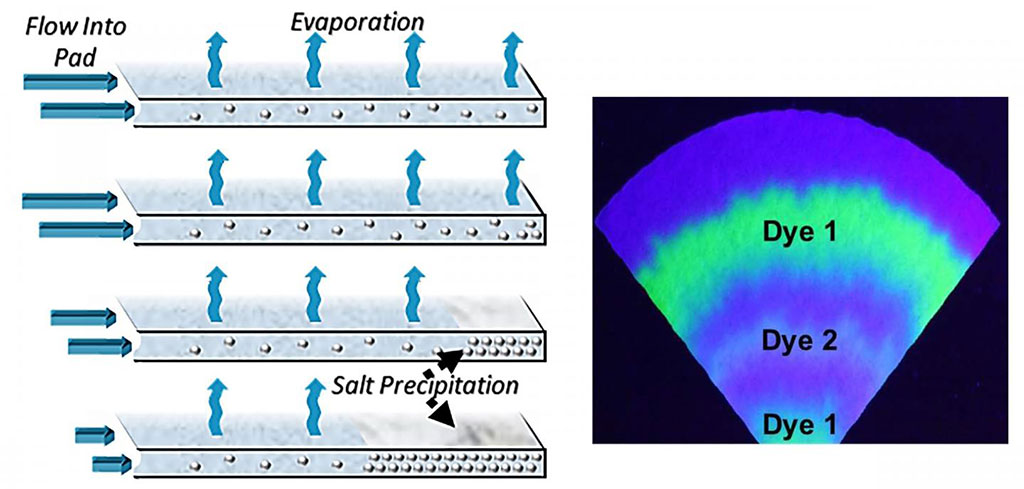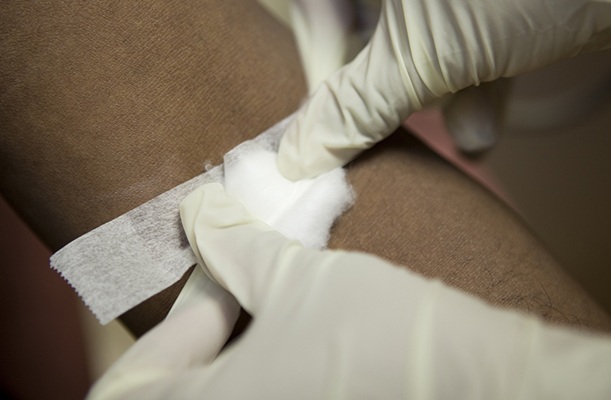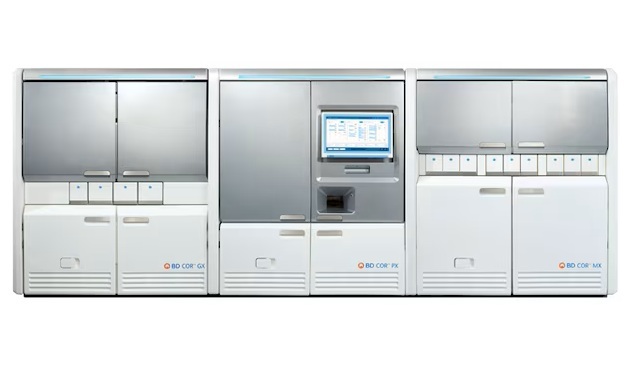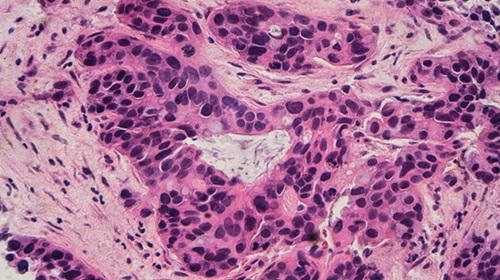A Simple Paper-Based, Wearable Device for Long Term Sweat Analysis
|
By LabMedica International staff writers Posted on 16 Jun 2020 |

Image: The evaporation of sweat on paper pads could be used for fluid transport in a wearable device over long periods of time. The resulting dry layer of caked salts would preserve a `time-stamped` record of biomarkers of interest (Photo courtesy of Dr. Orlin D. Velev and co-authors, North Carolina State University)
By cleverly manipulating paper geometry, researchers created a paper-based wearable device to collect, transport, and analyze sweat for an extended period.
Sweat can be used to obtain an exact measurement of concentrations of medications in the blood. Furthermore, the concentrations of stress biomarkers (hormones and neurotransmitters) in bodily fluids such as sweat predict the physical and mental state of the individual.
A major problem that has so far restricted the use of wearable paper-based sweat sensors is that sweat contains salt, which, upon evaporation, becomes deposited on the device and interferes with fluid flow. To solve this problem, investigators at North Carolina State University (Raleigh, USA) characterized and analyzed how capillary action and evaporation could cooperatively be used to transport and process a sweat-like fluid containing dissolved salts and model analytes.
The investigators postulated that the joint action of capillary wicking and evaporation would sustain continuous and long-term withdrawal of the sweat-like fluid. In the laboratory they then demonstrated that paper strips of controlled geometry could passively pump fluid for sensing purposes for long duration. Thus, non-invasive osmotic extraction combined with paper microfluidics and evaporative disposal enabled sweat collection and monitoring for periods exceeding 10 days. Since the process was driven by the liquid wicking through paper, the device did not require an external power source.
The investigators also demonstrated that the salt film deposited at the evaporation pad would eventually lead to cessation of the process but at the same time would preserve a record of analytes that could be used for long-term biomarker monitoring in sweat.
"We expected that the flow of the model sweat will be suppressed by the deposition of a salt layer inside the drying pad," said senior author Dr. Orlin Velev, professor of chemical and biomolecular engineering at North Carolina State University. "By following the flow of model sweat, we found, quite surprisingly, that such a simple paper construct can achieve continuous sweat pumping and disposal for very long periods."
The wearable device for sweat analysis was described in the June 9, 2020, online edition of the journal Biomicrofluidics.
Related Links:
North Carolina State University
Sweat can be used to obtain an exact measurement of concentrations of medications in the blood. Furthermore, the concentrations of stress biomarkers (hormones and neurotransmitters) in bodily fluids such as sweat predict the physical and mental state of the individual.
A major problem that has so far restricted the use of wearable paper-based sweat sensors is that sweat contains salt, which, upon evaporation, becomes deposited on the device and interferes with fluid flow. To solve this problem, investigators at North Carolina State University (Raleigh, USA) characterized and analyzed how capillary action and evaporation could cooperatively be used to transport and process a sweat-like fluid containing dissolved salts and model analytes.
The investigators postulated that the joint action of capillary wicking and evaporation would sustain continuous and long-term withdrawal of the sweat-like fluid. In the laboratory they then demonstrated that paper strips of controlled geometry could passively pump fluid for sensing purposes for long duration. Thus, non-invasive osmotic extraction combined with paper microfluidics and evaporative disposal enabled sweat collection and monitoring for periods exceeding 10 days. Since the process was driven by the liquid wicking through paper, the device did not require an external power source.
The investigators also demonstrated that the salt film deposited at the evaporation pad would eventually lead to cessation of the process but at the same time would preserve a record of analytes that could be used for long-term biomarker monitoring in sweat.
"We expected that the flow of the model sweat will be suppressed by the deposition of a salt layer inside the drying pad," said senior author Dr. Orlin Velev, professor of chemical and biomolecular engineering at North Carolina State University. "By following the flow of model sweat, we found, quite surprisingly, that such a simple paper construct can achieve continuous sweat pumping and disposal for very long periods."
The wearable device for sweat analysis was described in the June 9, 2020, online edition of the journal Biomicrofluidics.
Related Links:
North Carolina State University
Latest Molecular Diagnostics News
- Blood Protein Profiles Predict Mortality Risk for Earlier Medical Intervention
- First Of Its Kind Blood Test Detects Gastric Cancer in Asymptomatic Patients
- Portable Molecular Test Detects STIs at POC in 15 Minutes
- Benchtop Analyzer Runs Chemistries, Immunoassays and Hematology in Single Device
- POC Bordetella Test Delivers PCR-Accurate Results in 15 Minutes
- Pinprick Blood Test Could Detect Disease 10 Years Before Symptoms Appear
- Refined C-Reactive Protein Cutoffs Help Assess Sepsis Risk in Preterm Babies
- Blood Test Accurately Detects Brain Amyloid Pathology in Symptomatic Patients
- New Molecular Test Improves Diagnostic Accuracy of Lyme Disease
- New Genetic Test Enables Faster Diagnosis of Rare Diseases
- Urine Test Detects Inherited Neuropathy Missed by Genetic Screening
- Genomic Test Predicts Risk of SCC Metastasis
- Microfluidic Device Predicts Pancreatic Cancer Recurrence After Surgery
- New Molecular Test Simultaneously Detects Three Major Fungal Infections
- Blood Test Guides More Effective Ovarian Cancer Treatment
- Liquid Biopsy Test to Enable Earlier Diagnosis of Numerous Cancer Types
Channels
Clinical Chemistry
view channel
Chemical Imaging Probe Could Track and Treat Prostate Cancer
Prostate cancer remains a leading cause of illness and death among men, with many patients eventually developing resistance to standard hormone-blocking therapies. These drugs often lose effectiveness... Read more
Mismatch Between Two Common Kidney Function Tests Indicates Serious Health Problems
Creatinine has long been the standard for measuring kidney filtration, while cystatin C — a protein produced by all human cells — has been recommended as a complementary marker because it is influenced... Read moreHematology
view channel
Platelet Activity Blood Test in Middle Age Could Identify Early Alzheimer’s Risk
Early detection of Alzheimer’s disease remains one of the biggest unmet needs in neurology, particularly because the biological changes underlying the disorder begin decades before memory symptoms appear.... Read more
Microvesicles Measurement Could Detect Vascular Injury in Sickle Cell Disease Patients
Assessing disease severity in sickle cell disease (SCD) remains challenging, especially when trying to predict hemolysis, vascular injury, and risk of complications such as vaso-occlusive crises.... Read more
ADLM’s New Coagulation Testing Guidance to Improve Care for Patients on Blood Thinners
Direct oral anticoagulants (DOACs) are one of the most common types of blood thinners. Patients take them to prevent a host of complications that could arise from blood clotting, including stroke, deep... Read moreImmunology
view channel
Gene Signature Test Predicts Response to Key Breast Cancer Treatment
DK4/6 inhibitors paired with hormone therapy have become a cornerstone treatment for advanced HR+/HER2– breast cancer, slowing tumor growth by blocking key proteins that drive cell division.... Read more
Chip Captures Cancer Cells from Blood to Help Select Right Breast Cancer Treatment
Ductal carcinoma in situ (DCIS) accounts for about a quarter of all breast cancer cases and generally carries a good prognosis. This non-invasive form of the disease may or may not become life-threatening.... Read moreMicrobiology
view channel
Rapid Assay Identifies Bloodstream Infection Pathogens Directly from Patient Samples
Bloodstream infections in sepsis progress quickly and demand rapid, precise diagnosis. Current blood-culture methods often take one to five days to identify the pathogen, leaving clinicians to treat blindly... Read more
Blood-Based Molecular Signatures to Enable Rapid EPTB Diagnosis
Extrapulmonary tuberculosis (EPTB) remains difficult to diagnose and treat because it spreads beyond the lungs and lacks easily accessible biomarkers. Despite TB infecting 10 million people yearly, the... Read more
15-Minute Blood Test Diagnoses Life-Threatening Infections in Children
Distinguishing minor childhood illnesses from potentially life-threatening infections such as sepsis or meningitis remains a major challenge in emergency care. Traditional tests can take hours, leaving... Read more
High-Throughput Enteric Panels Detect Multiple GI Bacterial Infections from Single Stool Swab Sample
Gastrointestinal (GI) infections are among the most common causes of illness worldwide, leading to over 1.7 million deaths annually and placing a heavy burden on healthcare systems. Conventional diagnostic... Read morePathology
view channel
AI Tool Rapidly Analyzes Complex Cancer Images for Personalized Treatment
Complex digital biopsy images that typically take an expert pathologist up to 20 minutes to assess can now be analyzed in about one minute using a new artificial intelligence (AI) tool. The technology... Read more
Diagnostic Technology Performs Rapid Biofluid Analysis Using Single Droplet
Diagnosing disease typically requires milliliters of blood drawn at clinics, depending on needles, laboratory infrastructure, and trained personnel. This process is often painful, resource-intensive, and... Read moreTechnology
view channel
AI Saliva Sensor Enables Early Detection of Head and Neck Cancer
Early detection of head and neck cancer remains difficult because the disease produces few or no symptoms in its earliest stages, and lesions often lie deep within the head or neck, where biopsy or endoscopy... Read more
AI-Powered Biosensor Technology to Enable Breath Test for Lung Cancer Detection
Detecting lung cancer early remains one of the biggest challenges in oncology, largely because current tools are invasive, expensive, or unable to identify the disease in its earliest phases.... Read moreIndustry
view channel
Abbott Acquires Cancer-Screening Company Exact Sciences
Abbott (Abbott Park, IL, USA) has entered into a definitive agreement to acquire Exact Sciences (Madison, WI, USA), enabling it to enter and lead in fast-growing cancer diagnostics segments.... Read more






















